Why Your Face Ages & What You Can Do
The human face is a complex interconnection of compartments, structures, and soft tissue. In a youthful face, this provides a harmonious smooth, and firm texture. But, as decades pass, the multifactorial aging process leaves features of lines, bony prominences, sunspots, sagging skin, and undesirable contours of the face.
Interestingly, the appearance of the skin is reflective of general health and contributes to the communication of social signals and emotion. There is evidence that suggests that emotions and facial expressions are impacted by aging. For example, negative facial expressions, which are more apparent with aging, have an indirect negative relationship to happiness. With the understanding of the aging process, corrective treatment programs and successful preventative strategies are very achievable.

Facial aging is a predictable process that begins in the early 20s and is influenced by genetic, environmental, and biological forces. Intrinsic aging results from changes to bone, ligaments, deep and superficial skin layers, and fat pads, muscle activity, and collagen development and breakdown.

There are multiple deep and superficial fat pads. With age, fat pads atrophy, leading to decreasing volume, having a consequential impact on surrounding tissue, ligament tone and structure. Facial bones recede, particularly the orbital bone and the maxilla, contributing to changes in the midface and cheeks and the under-eye region. Thus, proportions and angles change.
Chronological age has been well correlated with skin age with increasing evidence of wrinkles, decreasing elasticity and thickness of skin, and flattening of the skin layers. Reduced hyaluronic acid, a water regulator for the skin, manifests itself as dry sensitive skin. The physical structure of the skin is highly impacted by increasingly impaired collagen formation and function. As years pass, fragmented collagen accumulates owing to the lack of tensile strength of the skin. Various muscle contractions become largely overactive due to the lack of structure and need to maintain facial expression.
As a result, once temporary lines from expressions, become wrinkles much like scars with age.

The skin is highly impacted by extrinsic or environmental factors, particularly UV exposure and smoking. Sun damage, superimposed on the aging of the skin, contributes exponentially to elastosis, inflammation of the skin, redness, and pigment changes, which is proportional to the degree of lifetime sun exposure. Common sun-related conditions of the skin are referred to as Rosacea and Melasma. Also detrimental to the skin includes a smoking history.
The pollents, and nicotine in cigarettes, cigars, and vaping products contribute to poor blood vessel formation and integrity, collagen breakdown, and impaired skin function. The skin of smokers, ages more quickly and harshly by comparison. A poor diet should also be considered, as over a lifetime, a diet lacking in nutrients and high in sugar can contribute to inflammatory diseases of the skin while limiting necessary building blocks for repair.
Genetics, ethnicity, and gender, also play a role in how well the face ages. For example, when it comes to aging of the face, darker skin types such Asians and Black descent fair much better due to having thicker skin layers, a greater amount of collagen, and more pigment which provides protection from photoaging. In fact, compared to a Caucasian, skin aging is slowed by approximately a decade. Men too, have an advantage, by a having thicker dermis, and hair follicles which aid in structure for the skin.
But, it’s not all bad news. With significant advances in medical research related to the dynamic aging sequence of the face, coupled with the explosion of Medical Aesthetic products and treatments now available, effective antiaging options have become accessible to most patients who want remediation.
Facial Rejuvenation
Facial aging treatments were once thought of as unnecessary and limited to a small population. Today, cosmetic medicine is a billion-dollar industry for good reason. It is now understood that aging of the face isn’t entirely predetermined by genetics and biology. Addressing structural changes of the skin, fat pads and bone reabsorption through the use of fillers, collagen stimulation and skin turnover devices and products can largely repair the structure, tone, texture and contours of the face that were once seen at a younger age.
Neurotoxins, commonly referred as “Botox”, provide a relaxation effect to the facial muscles, aiding in promoting positive messages of the face. The neurotoxin effect of relaxing muscles also allows the skin time to build collagen and resurface, thereby promoting the reparation of wrinkles.
The plethora of treatment options for the various facial aging concerns, begs the importance of carefully choosing and aligning the treatment to the goal and provider of the treatment. Each treatment option including injectables of hyaluronic acid dermal fillers, neurotoxins; energy-based devices plus alternatives, skincare products have their place in providing an excellent treatment option.

Achieving best results may require more than one treatment option or layering of therapies depending on the age and health of the patient, degree of sun damage or aging changes evident. But the decision as to what treatment plan is best requires partnering with a skilled medical practitioner.
Knowledge regarding each treatment option and related skill is paramount in order to deliver optimal outcomes while avoiding adverse events. Furthermore, not all devices provide equal results, and should be individualized for the concern and goal, as well as the unique biologic, genetic and ethnic factors of the patient. Clinical expertise allows for this individual characteristic consideration, for achieving synergism through layering of treatments and adjunct therapies. Optimal antiaging outcomes should be the expectation, not the exception.
If you are interested in facial rejuvenation, Preventous Cosmetic Medicine cosmetic doctors and nurse practitioners can assess the right treatment plan for your individual needs. To book your complimentary consultation, call/ text 403.229.0129 or chat with us here.
Frances Krawiec
Nurse Practitioner